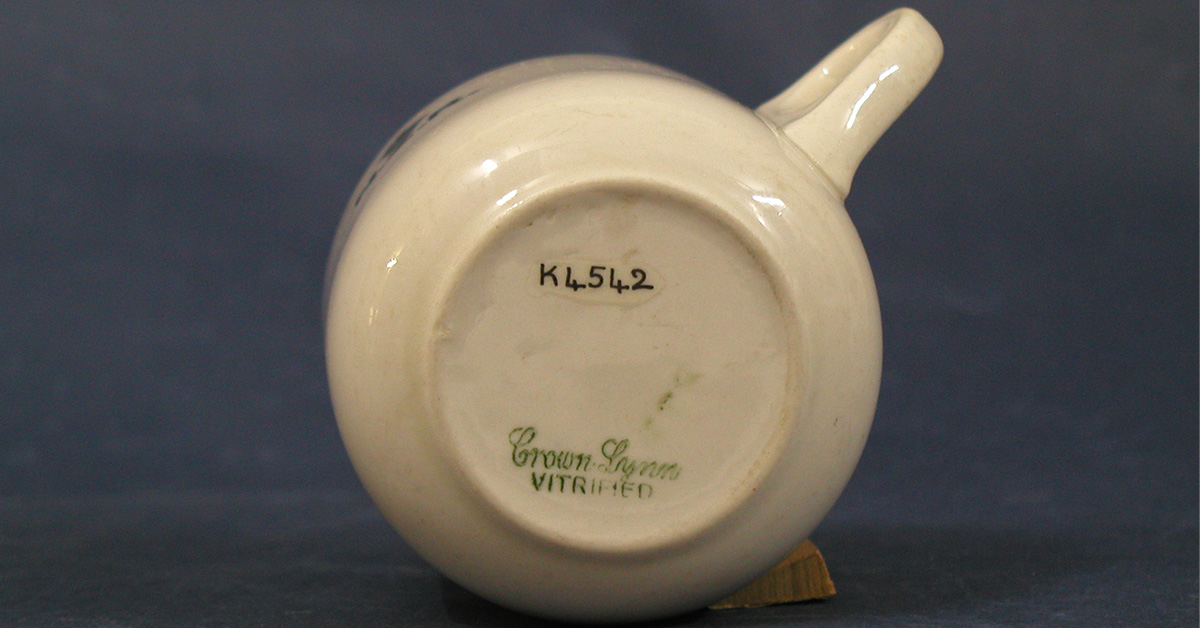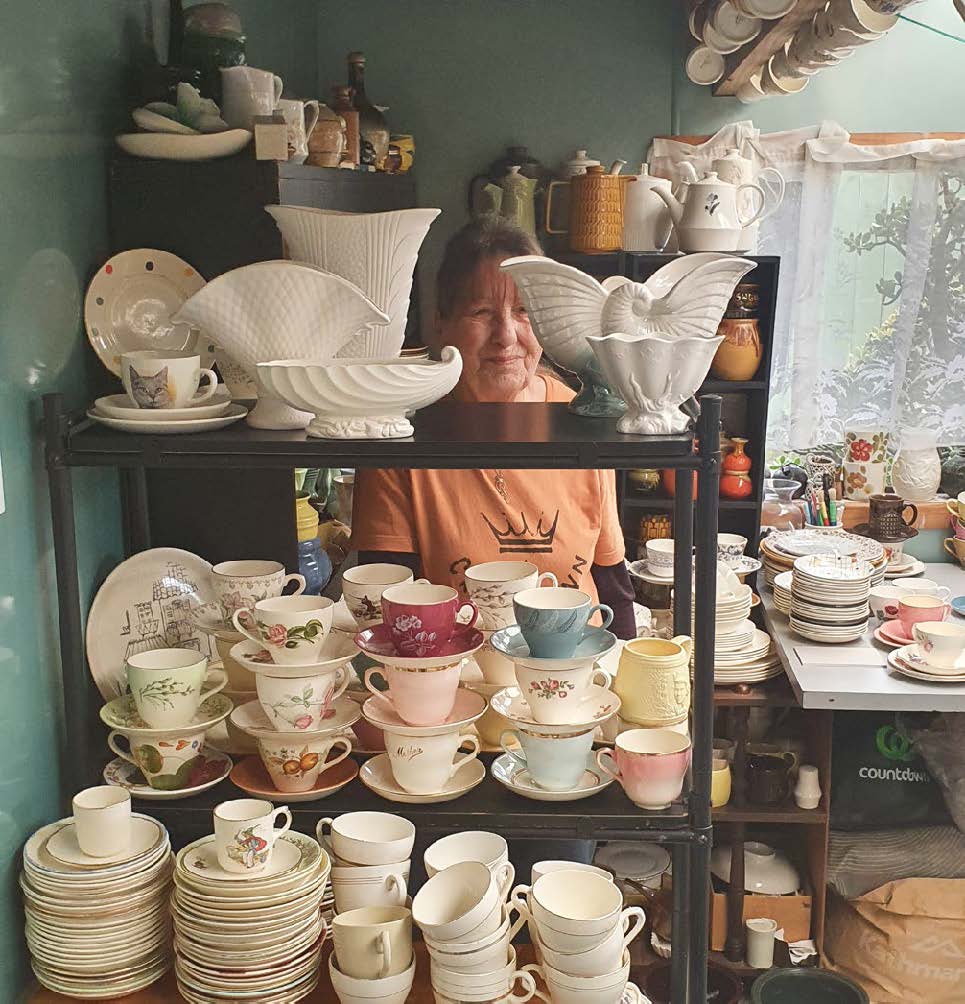
Culture Etc.

Above: It’s a wonder any New Zealand Railways cups still exist, as throwing them out the window, especially in tunnels where they would smash against the sides, was a popular entertainment on long train journeys. Photo courtesy Auckland Museum.
Crowning Glories
Crown Lynn, the New Zealand-made crockery brand that can still be found in many homes around the country, inspires an unmatched devotion among its collectors.
By Gabi Lardies
“Fat bums”, “oldies”, “tulips on steroids”, and lots of number codes. Welcome to the world of Crown Lynn collecting. You’ll hear these terms often if you spend time with the superfans who devote much of their spare time to crockery. They refer, in turn, to tea cups with a broad, rounded base; pieces from the 1950s; jumbo-sized tulip tea cups; and the numbers, often imprinted onto the bottom of crockery, which are used to identify and verify each piece. Other readily-bandied fan terms include “jealous”, “score”, “enabler”, “bargain”, “stunning”, and “fabulous”.
On the street, you might spot these collectors by what they wear: demin jackets with a Crown Lynn stamp printed on the back; pendant necklaces upcycled from broken plates; and tote-bags printed with swan-shaped vases casually slung over shoulders. Or the giveaway could be the tattoos; Crown Lynn logos from various eras etched onto forearms and fingers. Online, you will find them congregating in Facebook groups like the “Crown Lynn Skite Site”, which has nearly 3000 members, comparing bargains and crowing about rare finds.
In real life, the Crown Lynn collector’s natural habitats are all manner of op shops, garage sales and markets, where they are usually found peering at the bottom of crockery pieces, or clutching a total bargain of a score while trying to act casual — or, as one person described it, “running around like a chicken trying not to show the excitement”.
For some, the Crown Lynn craze (not to be confused with crazing, which is when a glazed surface “cracks” into little vein-like speckles of discolouration, and to which many Crown Lynn items are victim) is practically vintage itself — the New Lynn factory closed in 1989, immediately increasing the value of second-hand finds, and Crown Lynn has been a mainstay of op shop shelves for decades.
In the past few years, however, the craze has hit the mainstream. During Covid lockdowns in 2020 and 2021, TradeMe bidding wars drove the prices of some of the brand’s most coveted items to astronomical heights. Last year it was reported that a baby swan vase, which might have sold for around $90 in 2019, went for more than $500, and a medium sized swan — rare for its black glaze — sold for a whopping $6,150. Op shops seem to know this too. You might have noticed that Crown Lynn tends to have its own special shelf at the Sallies now, and that the prices for pieces in good nick — even the more common designs — are a fair whack higher now than they were even a few years ago.
For hardcore collectors, purchasing from TradeMe is considered “succumbing”, as in, succumbing to the temptation of an easy click in order to obtain the treasure, rather than do the work of hunting “in the wild” — a much preferable and higher status way to find a piece. When finds are shared online, the bigger the bargain, the prouder the post. A photo of a white Crown Lynn butter dish from the 1950s, embellished with pink and yellow roses, is posted with its price sticker still attached — 20 cents. Total bargain, just fabulous. A little blue vase, its glaze bright but patchy, is posted with a $2 price sticker on its side. Stunning find. Rarer pieces, like the instantly recognisable and much-coveted swan vase are almost always posted without mention of their price.
Every morning, Paul R Thomas drinks his tea from the same glossy white Crown Lynn railway cup, a simple, heavy thing with a rounded bottom and little ear-like handle. “If I drop this,” Thomas says, “the ground’s gonna break before the cup.”
Thomas, now 69, has been a collector since he found collectable cards in his Weet-Bix boxes as a wee boy in the late 1950s. After the cards, he became preoccupied with old labels at the back of his grandparents’ pantry that caught his eye, and which he would carefully stick into albums. He describes his collecting as driven by a “primal instinct to hunt”. The thrill of collecting is a careful balance, he says. What you’re looking for can’t be too common or else not exciting to find, nor can it be so rare that you’re too often deflated. Most importantly, there needs to be a sense of purpose when you’re hunting, and a sense of accomplishment when the perfect object is found.
When showing off his collection he is apt to turn each piece of crockery around slowly, admiring it in full, before declaring that he just “couldn’t leave this one behind”. His affection for his collection is enduring, but it’s not necessarily the object in and of itself which brings him joy. “If I was honest, it’s the looking,” he says; the thrill of the find which becomes synonymous with the thing itself. Thomas is thrifty, and a lot of Crown Lynn is still pretty cheap — many of his pieces were bought for less than a tenner, and some less than a dollar. Other pieces, like an elegant white lamp base in an art deco style and with three stylised women’s faces (named “Three Faces of Eve”) he is more circumspect about, remaining tight-lipped when asked how much it cost. The women appear peaceful, with their eyes closed and their hair ending in neat curls. An identical piece sold for $4,620 on TradeMe early last year. “If it’s something you really want, price is no object,” is all Thomas will say.
His railway cup is an early Crown Lynn design, and one that Thomas finds completely appropriate for daily use. There are tiers of Crown Lynn, you see, based on how difficult they are to find, and only some are worth the risk of actually putting in your kitchen cupboards (though any serious collector would insist that all should be kept away from evil dishwashers).
Then there are pieces too precious to touch — except that having dust on them is also unacceptable, so they must be cleaned fairly regularly. At Thomas’ Gisborne home, tucked in the corner of a vintage cabinet in his lounge, is a white Crown Lynn Apollo dinner set complete with dinner plates, lunch plates, bowls, cups and saucers.
First made in 1969, the set is named for the American moon-mission programme and with its fluted edges and rims, it was both practical and popular. As a child, Thomas’ parents were gifted a blue and white English dinner set as a wedding gift, but in an unfortunate accident, his father dropped the lot. It was promptly replaced with a brand new Apollo set.
The set in Thomas’ cabinet is a replica of that initial set, made of rescued plates which were pieced together over years from various scores. It took him a long time to do this, but Thomas is philosophical about it, comparing time to a piece of string. It wouldn’t take as long if Thomas wasn’t so particular. He rejected many perfectly fine Apollo pieces, for example, because they lacked the original backstamp of this particular set, which meant they had been made in a later era and therefore were not “authentic” enough for his exacting standards.
Though his Apollo set is now complete, Thomas isn’t finished. He is currently looking for four particular bowls which have eluded him for close to 10 years. He op shops daily, starting at 10 in the morning, before all the best new treasures have been snapped up. Once an accountant, he is enjoying his retirement with a structured schedule: four hours of op-shopping followed by two at the gym, and then a quick visit to the supermarket on his way back home each day. In a spare room are piles of bowls, plates and saucers on the floor, on the bed, and every other surface — more sets to complete. “They’re out there,” he says of the missing pieces. “Fingers crossed they will turn up for me one day.”
Many ardent Crown Lynn collectors are, like Thomas, of fairly modest means. They’re teachers, medical receptionists, retirees, labourers, delivery drivers and gardeners. They are the same people who would have purchased the pieces brand-new: ordinary New Zealanders. Crown Lynn made pragmatic crockery, aiming for broad appeal. There’s crockery for pockets of all depths: pieces at the high-end, rare and artful, like the Three Faces of Eve or the swans. Then there are the five decades’ worth of the everyday plates, mugs, and gorgeous little butter dishes. There are the “oldies”; tea cups modelled after English china; the brown honeyglazes (also known as the “ugly mugs” for their distinctly indelicate designs), as well as pieces with orange-toned retro patterns, and those with floral designs hand painted in lively strokes.
Thomas laments what he sees as a “diminishing supply”, due to Crown Lynn’s increasing popularity, but mostly he’s happy it’s being treasured — and that recently, he’s had some lucky finds.

Photo courtesy Ev Williams.
Sociologist Dr Claudia Bell of the University of Auckland wasn’t necessarily looking for Crown Lynn, but she kept finding it anyway. A researcher of Pākehā national identity, her fieldwork has included visiting the homes of “Kiwiana” collectors around the country. Often associated with locally produced objects from the post World War II period, the quirky aesthetic of Kiwiana represents a burgeoning New Zealand Pākehā identity in the 20th century.
Some homes Bell visited had their owner’s vast collections of Kiwiana curiosities carefully curated and arranged for display, others were so full of knick-knacks that their rooms were difficult to move around in. One enthusiastic collector told Bell that his partner had implemented a single, strict rule: that the space between the couch and the coffee table be kept clear at all times. (This calls to mind a man I spoke to whose wife banned much of his collection from the house, meaning much of it is boxed up in their garage. Still, he continued to search for, find, and buy Crown Lynn.)
Over and over on these visits, she would spy Crown Lynn among the collections. She discovered that collectors were able to tell her stories about their pieces, as well as the company itself: the charming personality of Sir Tom Clark, who was known as the driving force behind Crown Lynn in its heyday; the retro patterns designed by Mark Cleverly, who has been formally recognised for his contribution to New Zealand design.
In many ways Crown Lynn is the perfect materialisation of Kiwiana, its story a microcosm of the history of the country. Bell ended up writing several papers specifically about the company, and the practice of collecting the crockery. The people she visited and talked to saw themselves as guardians of national artefacts, preserving a slice of history by keeping these objects safe. Their collecting was a form of nation building, she argued, on an intimate, domestic scale.
The Crown Lynn story embodies many of the values we pride ourselves on in this country . In the mid 1850s, an enterprising farmer began making his own giant clay pipes in order to drain his paddocks, which led to him founding a clay works in New Lynn in west Auckland in 1964. The factory thrived, producing pipes, industrial tiles, bricks and chimney pots. In 1935, the Amalgamated Brick and Pipe Company began producing domestic wares under the name Ambrico: plates, cups, jugs and bowls, vases, and sweet little figurines, often in the shape of stout farm animals or birds.
The early crockery was thick, heavy and basic. Some of the first cups produced, for the railways, were infamous for their unreliable handles, which would break off as people attempted to sip their tea. In 1948, the company was renamed Crown Lynn. It began to produce crockery of a higher standard: elegant tea cups with golden rims, often sporting flowers on their sides. The designs moved with the times, including the floral eras of both Fleurette and Echo, the brown-hued leaves of Autumn Splendour, the bold Colour Glaze, and the more geometric patterns of Rewa.
But the pull of Crown Lynn isn’t solely about its history, or its design qualities. Nor is it logical — it’s nostalgic. Crown Lynn was what you’d find in your grandparents’ cupboard, or in your parents’ “good” crockery cabinet. All the collectors Bell visited remembered Crown Lynn from their childhoods, the plates reminding them of home-baked scones, Christmas dinners, and meals lovingly cooked by family.
Crown Lynn also lends itself well to hunting — some of it is everywhere, meaning it’s an easy brand to get into collecting, but there’s always rarer pieces to try to find, which keeps things interesting and fun. Finding it can be an adventure, and Bell found that people made new memories through the act of collecting itself.
Ev Williams, an Auckland-based Crown Lynn super hunter, is trying to find just one of everything the company has ever made. Once a potter herself, Williams is now retired and spends much of her time researching Crown Lynn.
She visits the archive at the Auckland Museum to inspect the records taken from the closed factory, seeks out pieces in op shops or on TradeMe, and spends time with her collection in her studio. Once a space for her own pottery making, the room adjoined to her garage in Manurewa is now full of shelves — hardly visible under all the tablewear they’re holding. Dinner plates in all colours and patterns are stacked 50-high. Mugs are hanging from the ceiling rafters on nails, like brussels sprouts growing off stems. There’s two (full) wooden lattice mug holders on the wall above the washing machine and mini fridge.
Williams has been called a hoarder, but to her, this is a working collection in the service of research. She is putting together a catalogue of every Crown Lynn shape and pattern ever produced, an impressive archive she hosts on newzealandpottery.net. It’s a well-used resource in the collecting community, and often used to identify pieces. She tends to find at least one new shape or pattern every week through her own hunting and with the help of other keen collectors, who often send her pieces in the mail. Williams thinks she might have catalogued about half of the crockery that was made. “I can’t see it slowing down, there’s still so much to find,” she says.
Trying to catalogue the entire output of what was for many years our biggest crockery manufacturer is no small undertaking. Williams knows that many people would think it was a boring thing to do, but to her it’s exciting. She’s animated by anecdotes from the factory, like the marketing team simply making up odd words to name patterns, or when someone fell into a barrel of wine at a Christmas party.
There’s an entire shelf stacked with her favourites — “the old girls”— delicate cups and saucers from the 1950s. “There are pieces with gardenias on their sides, bands of pastel colours, little polka dots, and golden rims. She simply can’t resist them. “It’s just my heart, they melt my heart.”

Ev Williams, seen here in her studio, must remind herself when she comes across her preferred teacups and saucers from the 50s that she already has plenty. Photo Aaron Williams.
At her home in Whangārei on a sunny September afternoon, Valerie Monk sips from a fairly nondescript porcelain mug made in China. She considers it to be uncollectable. “It’s sturdy, attractive to look at, but it’s not got anything about it that says New Zealand,” she says. “You can have the most exquisite English bonechina cup and saucer, that makes your heart sing, but it’s worth nothing. People don’t feel the love for it the way that they do for New Zealand-made.”
A researcher and writer, Monk’s two books on Crown Lynn (Crown Lynn: A New Zealand Icon and the Crown Lynn Collector’s Handbook) are regarded as collectors’ “bibles”. She says she had always recognised that Crown Lynn was something special, and couldn’t understand why no one had written about it before.
Collecting might seem like a trivial eccentricity, but the objects stand for more than a quirky hobby. Collectors are determined to preserve the things which make New Zealand unique, and have been a part of their own lives, that might otherwise disappear.
On a Sunday in early November, stall holders lay out their wares at the biannual Crown Lynn Collectors Market in the New Lynn Community Centre. Fold-out tables are dressed in vintage table cloths and loaded up with crockery: pieces from the 50s, 60s, 70s and 80s sit side by side. People mill around, looking for two bowls to match another two already at home, or four missing plates for their dinner set. Others eye up the expensive swans and vases.
Over the next few days, collectors share their market purchases online. There are mugs with bright diagonal stripes, bold coloured egg cups, vitrified blue speckle dinner plates. “Good score,” comments one collector. A chorus chimes in, “nice haul! I bet you had a ball,” one person writes. “Love the green mugs,” says another. Then, from someone anxious to have missed out: “When is the next one?”
Gabi Lardies is North & South’s junior writer, a role made possible by NZ On Air’s Public Interest Journalism fund.

This story appeared in the January 2023 issue of North & South.
